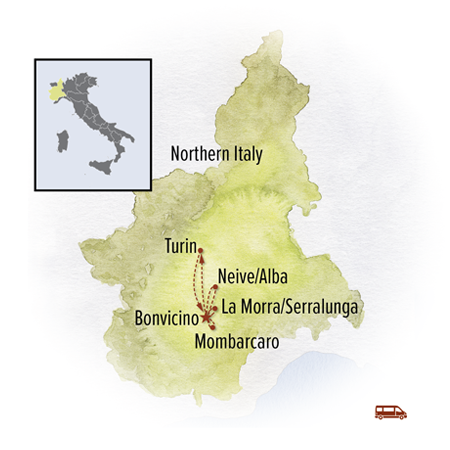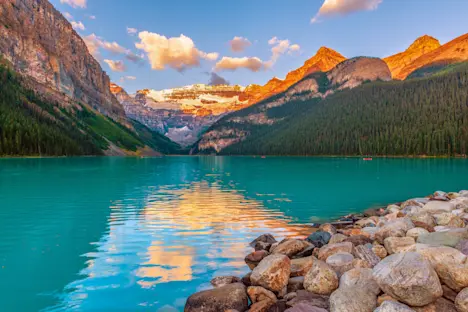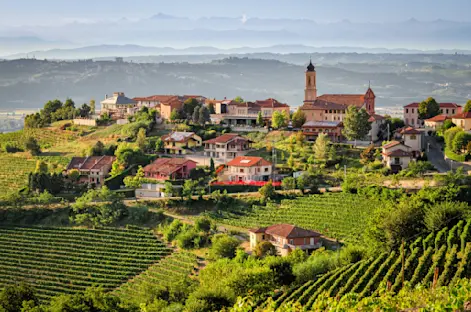Itinerary

Meet your Expedition Leader and fellow travelers at Turin’s central Porta Nuova train station at 2:00 pm, then travel to Villa San Lorenzo, about an hour outside the city, where we enjoy a welcome aperitivo as we get settled in. Get an overview of all the culinary adventures that lie ahead as we learn about the local winemakers, chefs, butchers, and farmers whose products you’ll taste during the week. Dinner follows at the villa, featuring fresh farm-to-table ingredients as the perfect introduction to the unique local food and wine culture of the Piedmont region.
Head into the forest this morning with a local truffle hunter, our friend Danilo, and his dog, Lila, to unearth the secrets of finding these prized fungi, known as “white gold” for their place in regional cuisine. Pursued in this region for centuries by skilled hunters, rare white truffles grow underground. Historically, pigs were used to help sniff them out, but dogs became favored for their precision and ease of handling. Festivals celebrate this heritage, blending folklore, community pride and culinary excellence, while preserving an enduring bond between people and nature.
Then, take in the unspoiled beauty of the Alta Langa region as we drive through an ancient landscape of high rolling hills covered in orchards and rows of grapevines, and dotted with tiny towns. Our destination is the medieval village of Albaretto della Torre, marked by its 12th-century tower rising from the parish garden. Here, at the heart of one of Italy’s most renowned wine regions, we are immersed in the world of Alta Langa sparkling wine, paired with local sheep and goat cheeses. For lunch, we’ll enjoy regional specialties at a tucked-away trattoria.
Return to our villa this afternoon where we learn to bake the local bread, finding out about the heirloom grains used to create the fine wheat flour going into our loaves. Dinner at the villa this evening features a favorite local specialty, plin in brodo, made with agnolotti pasta: tiny thumb-sized pouches filled with roasted meats, vegetables and cheeses. The name plin comes from the Piedmontese word for "pinch," referring to the hand-pinching technique used to seal the pasta, while brodo means broth, which the pasta is served in.
Begin your day with a gourmet breakfast dish, savoring Piedmont’s celebrated truffles atop fried eggs. Then head to Cascina Barroero in the Alta Langa to discover another culinary prize, the Tonda Gentile hazelnut. Regarded as the world’s finest hazelnut, this variety has been cultivated in Piedmont since ancient times, with many modern-day groves stewarded by family farmers whose heritage extends back generations. We’ll get to sample an array of decadent pastries and chocolates made with Nocciola Piemonte, the famed hazelnut of this region.
Continue to the Romanesque church of Santa Maria before lunch at Pascoli di Amaltea, an organic farm in Mombarcaro. Our hosts raise sheep—the old pecora di Langa breed, specifically—and goats for milk and cheese, and our meal features seasonal creations made with their artisan products. Back at the villa, more gastronomic discoveries await as guest chef and winemaker Marco Battaglino, a noted name in Italy's Slow Food movement, guides us through a hands-on cooking class of Piedmontese classics, paired with his own Dolcetto and Timorasso wines.
This morning, we're immersed in the sensory delights of Dogliani market, where we enjoy a classic Italian coffee and croissant. Wander with the locals among the more than 80 stalls that line the central piazza and side streets, enjoying the sights and aromas of the market’s bounty. Stands heaped with dozens of local cheese varieties, hazelnut cakes, honey, truffles and olive oil neighbor others selling salami, handmade pasta, seasonal fruits and vegetables, and fresh flowers.
Then it’s time to discover the nuances of terroir on a visit to Serradenari in La Morra. Here, we taste renowned local vintner Giulia Negri’s elegant wines, made from the highest-altitude Nebbiolo grapes grown in the Barolo region. Facing the Alps, Serradenari is known for its unique microclimate and varied soils, producing aromatic Nebbiolo wines with fine tannins and bright acidity, and flavors that vary from one hillside to the next. A leisurely lunch at Osteria Veglio offers superb vineyard views, accompanied by celebrated reds.
Next, we’re off to explore the historic hilltop towns of Serralunga d’Alba and Monforte d’Alba in the heart of Barolo, their rustic stucco buildings with red-tiled roofs surveying the tapestry of vineyards below. Once we return to the villa, learn the art of making risotto with rice sommelier Valentina. Wine pairings enhance the dinner our hands create, with Piedmontese hospitality suffusing every moment of our experience.
Descend from the rural Alta Langa heights to discover Turin, Piedmont’s sophisticated capital on the Po River. With a richly layered history dating back to pre-Roman times, Turin was the first capital of a united Italy from 1861-1865. A royal city and archibishopric for centuries, Turin is replete with many fine palaces and churches. With our local guide Sandro, wander grand piazzas and regal avenues, pausing at one of the city’s Art Nouveau cafes to sip Turin’s signature Bicerin—a velvety blend of espresso, and chocolate ganache with a foamy milk cap. Learn about the city’s history and culture as we stroll its elegant arcades lined with boutiques and gelaterias.
Once we’re back at Villa San Lorenzo, dinner awaits, followed by a nightcap featuring Turin’s famous vermouth. The fortified wine was created in Turin in 1786 by Antonio Benedetto Carpano, a Piedmontese herbalist who soaked botanicals in spirits, then added them to the aromatic Moscato wine—a concoction he called vermouth. The Savoy king, whose royal palace was located across from Carpano’s lab, became a fan, and soon vermouth was the preferred aperitivo of the city’s residents, gaining worldwide renown.

Begin with a sweet stop at a tiny pasticceria in Bossolasco, known as the “Rose Village” for the fragrant floral displays that line the roadsides of this small hill town. Continue to Barbaresco, Piedmont’s other wine appellation (along with larger Barolo) based solely on the Nebbiolo grape. Nebbiolo thrives in the humid conditions of the Piedmont region, and the complex wine made from this robust grape is known for its floral aromatics, high acidity and firm tannins.
At Azienda Agricola Paitin, a family-owned wine estate in Neive that dates to 1796, learn the nuances of Nebbiolo’s noble Barbaresco expression. Then enjoy a traditional lunch at Antica Torre, a traditional trattoria located next to Barbaresco’s ancient tower. The intimate restaurant’s signature dishes are its handmade tajarin, a Piedmontese type of tagliatelle, and insalata russa, a classic Italian vegetable salad.
Continue to Alba, one of the main towns within the Vineyard Landscape of Piedmont, a UNESCO World Heritage Site inscribed as a "cultural landscape," reflecting the combined interaction of humans and nature. Alba is world-renowned for its white truffles—Italy’s most valuable variety. You may wish to explore the city’s Truffle Museum, celebrating the heritage of this prized gastronomic ingredient, or trace its roots to Roman times on a walk through the historic center. You may catch a whiff of chocolate in the air as you wander: the original Ferrero factory, founded in 1946, is located here, the producer of famous Ferrero Rocher hazelnut chocolates and Nutella spread. Conclude the evening back at the villa with a festive farewell dinner featuring a wood-fired meal, as we are joined by local winemaker friends to toast a fabulous week of culinary adventures.
Enjoy a last taste of Piedmont at breakfast this morning before departing Villa San Lorenzo to transfer to the airport in Turin. (Please schedule departing flights after 3:00 PM). You’re sure to take a great deal home with you when it comes to savored memories, newfound culinary inspiration, and a deep appreciation for Piedmont’s rich cultural heritage.

































